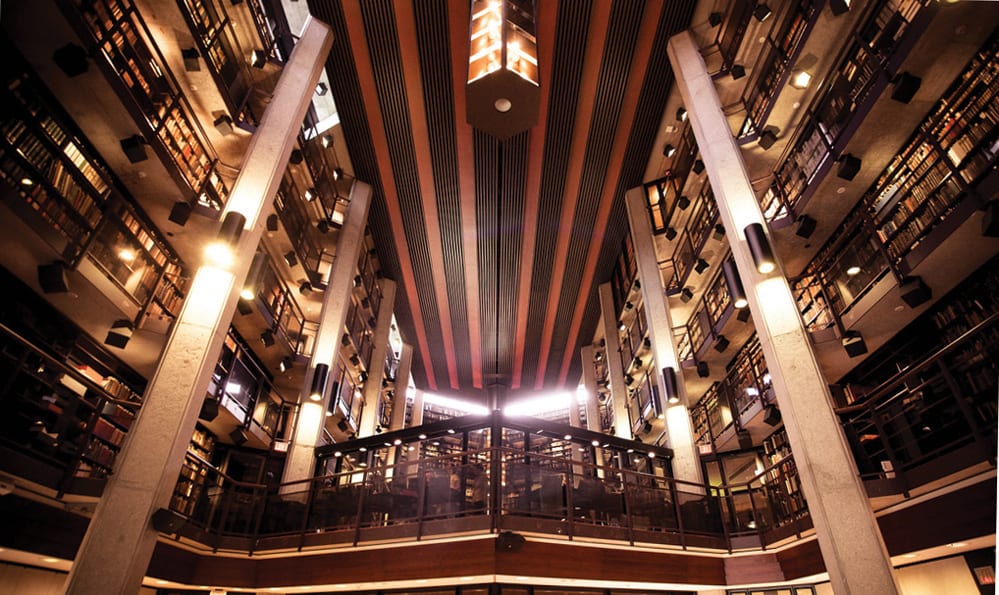For book lovers, the Thomas Fisher Rare Book Library is nothing short of paradise. With stunning architecture and precious books of every shape and length, using the resources at Fisher can seem like a real treat. The best part of all? Everybody gets to handle the books.
“Our attitude here is that we’re a library not a museum, so we want people to use our items,” John Shoesmith, Fisher’s outreach librarian, says proudly. “The only things you really see behind glass are what you see in the exhibitions here… we always tell people, ‘Don’t be afraid of the books!’”
And what an array of books there is, with approximately 700,000 volumes, the open stacks themselves can only feature about one-seventh of the collection itself, with the rest stored away safely below the library. Fisher’s collection strengths include: history of science and medicine, theology, philosophy, European literature, history of books and printing, Darwin, and Canadiana, just to name a few. They also have manuscript and archival material from writers such as Margaret Atwood and Leonard Cohen, as well as Frederick Banting’s notes on topics such as his discovery of insulin and Nobel Prize.
“When people think rare books, they always think it must just be really old books, but in fact rarity takes all forms, and so we want things that are being produced today that have a real rare value,” says Shoesmith. This includes Canadian small and fine presses, featuring publishers like Barbarian Press, who skip the computer in favour of a 500-year-old hand-printing process, first begun by Gutenberg.
Recently, Fisher has acquired two highly publicized collections: the General James Wolfe letters and Allen Ginsberg’s photo collection. “The Wolfe letters were a long time in the making, but it was held up in Britain because there was concern that we were taking something that was culturally important to the United Kingdom out of the country,” explains Shoesmith. “But we made a case for the fact that Wolfe really had such a strong role to play in Canadian history that the letters would find a good and proper home here.” Once catalogued, these 270 letters will join the rest of Fisher’s Wolfe collection, which includes the annotated copy of Thomas Gray’s Elegy Written in A Country Churchyard, that Wolfe was carrying with him to the Battle of the Plains of Abraham in 1759. (A little trivia factoid: Wolfe’s copy of Gray’s Elegy was purchased as U of T’s ten millionth book in 1987).
The Ginsberg photographs were a donation from the Rossi Family Foundation in Montréal and includes 7,000 photographs.
Some of the larger format pictures were sent to the University of Toronto Art Centre, but the bulk of the collection remains at Fisher. “They essentially chronicle Ginsberg’s early years during the early Beat period; so William Burroughs, Jack Kerouac, Gregory Corso, all those major figures are captured by Ginsberg’s camera, up until the 1990s,” Shoesmith adds enthusiastically. “Ginsberg lived such an incredible life, not just as a poet but as a major cultural figure, so we’re really lucky to have those!”
In today’s online world where so much emphasis is placed on digital accessibility, Fisher has a rather unique viewpoint on digitization. “Digitizing is not preservation; it’s another means of accessing the work and is certainly not a replacement for the actual object itself,” details Shoesmith. “When we digitize things, the real hope for us is that it intrigues people enough to come in and look at the actual item themselves, and I think that does happen. I mean, you could download off the Internet archive the first edition of Jane Austen’s Pride and Prejudice, but there’s something special about holding the original 1813 copy in your hands.”
While Fisher can initially seem intimidating to undergrad students, Shoesmith and the rest of the staff are putting a lot of effort into making it seem as friendly as possible. “We have our Facebook, Twitter, and Instagram — we’re trying to do all the social media stuff too,” laughs Shoesmith. To use the collections, all you need is to get a Fisher reader card at the front desk and send in a request for the book you want.
Fisher is always open for anyone to use, even the public, and with such a wealth of collections, it’s easy to find a reason to spend an afternoon poring over old books in this beautiful library.


